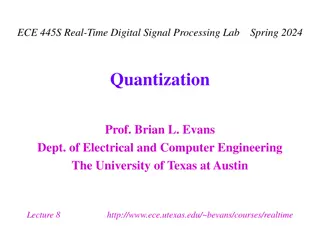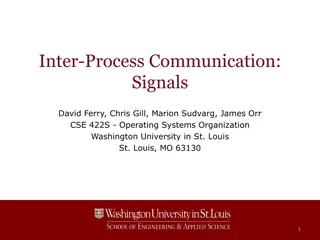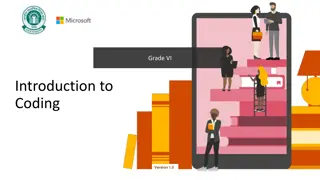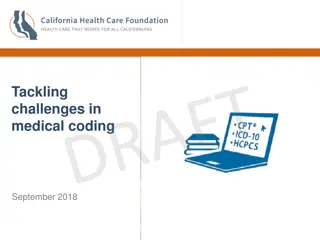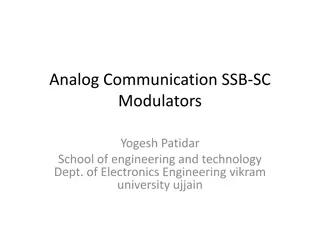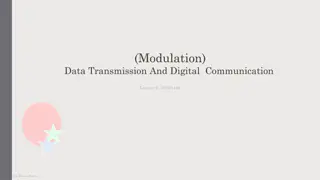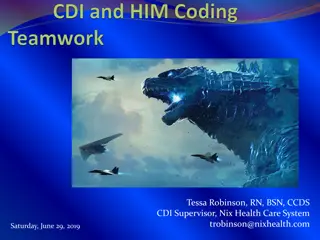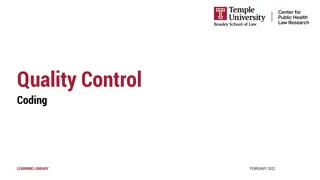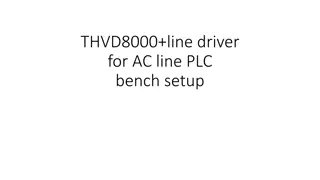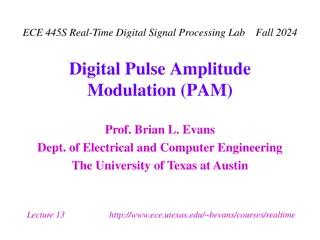Introduction to Line Coding and Digital Signal Transmission
Line coding is the process of converting binary data into digital signals, essential for digital transmission. Unipolar and polar encodings are discussed, highlighting the use of voltage levels to represent data. Digital signals, offering noise immunity and data compression, are crucial for efficient communication.
Download Presentation

Please find below an Image/Link to download the presentation.
The content on the website is provided AS IS for your information and personal use only. It may not be sold, licensed, or shared on other websites without obtaining consent from the author. Download presentation by click this link. If you encounter any issues during the download, it is possible that the publisher has removed the file from their server.
E N D
Presentation Transcript
(Line Encoding ) Data Transmission And Digital Communication Lecture 6 2019/1440 By: Elham Sunbu
OUTLINE What is line coding? Line coding schemes. - Unipolar encoding; NRZ - Polar encoding; (NRZ, NR, Manchester, Differential Manchester) Line coding examples.
Digital Transmission Digital transmission is the sending of information over a communications media in the form of digital signals. Digital signals are a sequence of voltage pulses. They can propagate analog and digital data. They offer better noise immunity, are cheaper to implement in hardware, more secure and also allow data compression, thereby optimally utilizing the transmission link. 3
Digital Signal Transmission Digital Data transmitted as Digital Signals Analog Data transmitted as Digital Signals 4
Digital Data Transmitted as Digital Signals To convert digital data into digital signals. It can be done in two ways, line coding and block coding. For all communications, line coding is necessary whereas block coding is optional. Here digital data is first encoded into a binary stream. These binary streams are then converted into digital signals by line coding techniques. 5
What is Line Coding? - is the process of converting binary data (a sequence of bits) to a digital signal. - Different line codes have different attributes. - Best line code has to be selected for a given application and channel condition. 6
Unipolar Encoding - Unipolar encoding uses only single voltage level to represent data. - It is also called Unipolar-Non-return-to-zero, because there is no rest condition - In this case, to represent binary 1, high voltage is transmitted and to represent 0, no voltage is transmitted 9
Polar Encoding - Polar encoding uses two voltage levels (positive and negative). - Polar encodings is available in four types: 10
Polar Encoding 1.1- Polar NRZL (Non Return to Zero) Level - Bit 0 is mapped to a negative amplitude. - Bit 1 is mapped to a positive amplitude. 11
Polar Encoding 1.2- Polar NRZI (Non Return to Zero Inverted) - Bit 0 mapped to no signal level transition. - Bit 1 is mapped to signal level transition at the beginning of the bit interval. Assumption: - The signal level to the left of the bit is high Fig. A and Fig. C - The signal level to the left of the bit is low Fig. B and Fig. D 12
NRZ-L changes voltage level at when a different bit is encountered whereas NRZ-I changes voltage when a 1 is encountered. 13
Polar Encoding 2- Polar RZ (Return to Zero) - Bit 0 is mapped to a negative amplitude - A for the first half of the symbol duration followed by a zero amplitude for the second half of the symbol duration. - Bit 1 is mapped to a positive amplitude +A for the first half of the bit duration followed by a zero amplitude for the second half of the bit duration. 14
Polar Encoding 3- Polar Manchester Coding - Bit 0 is sent by having a mid-bit transition from high to low. - Bit 1 is sent by having a mid-bit transition from low to high. 16
Polar Encoding 4- Polar Differential Manchester Coding -Bit 0 is mapped to signal level transition at the beginning of the bit interval. - Bit 1 is mapped to absence of signal level transition at the beginning of the bit interval. Assumption: The signal level to the left of the bit is high Fig. A and Fig. C The signal level to the left of the bit is low Fig. B and Fig. D 17
Bipolar Encoding Bipolar encoding uses three voltage levels, positive, negative and zero. Zero voltage represents binary 0 and bit 1 is represented by altering positive and negative voltages. 20
Thank You 22



